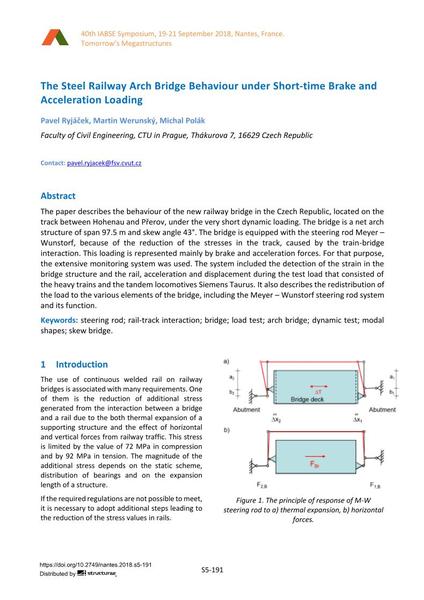The Steel Railway Arch Bridge Behaviour under Short-time Brake and Acceleration Loading

|
|
|||||||||||
Détails bibliographiques
| Auteur(s): |
Pavel Ryjáček
(Faculty of Civil Engineering, CTU in Prague, Thákurova 7, 16629 Czech Republic)
Martin Werunský (Faculty of Civil Engineering, CTU in Prague, Thákurova 7, 16629 Czech Republic) Michal Polák (Faculty of Civil Engineering, CTU in Prague, Thákurova 7, 16629 Czech Republic) |
||||
|---|---|---|---|---|---|
| Médium: | papier de conférence | ||||
| Langue(s): | anglais | ||||
| Conférence: | IABSE Symposium: Tomorrow’s Megastructures, Nantes, France, 19-21 September 2018 | ||||
| Publié dans: | IABSE Symposium Nantes 2018 | ||||
|
|||||
| Page(s): | S5-191 | ||||
| Nombre total de pages (du PDF): | 7 | ||||
| DOI: | 10.2749/nantes.2018.s5-191 | ||||
| Abstrait: |
The paper describes the behaviour of the new railway bridge in the Czech Republic, located on the track between Hohenau and Přerov, under the very short dynamic loading. The bridge is a net arch structure of span 97.5 m and skew angle 43°. The bridge is equipped with the steering rod Meyer – Wunstorf, because of the reduction of the stresses in the track, caused by the train-bridge interaction. This loading is represented mainly by brake and acceleration forces. For that purpose, the extensive monitoring system was used. The system included the detection of the strain in the bridge structure and the rail, acceleration and displacement during the test load that consisted of the heavy trains and the tandem locomotives Siemens Taurus. It also describes the redistribution of the load to the various elements of the bridge, including the Meyer – Wunstorf steering rod system and its function. |
||||
| Mots-clé: |
pont pont en arc
|
||||
